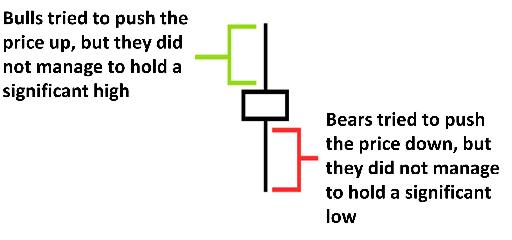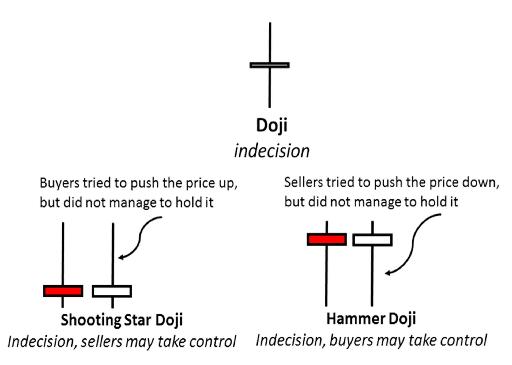Indecision Candlesticks
Dojis: Simple, Shooting Star, Hammer
Dojis are an important candlestick pattern and come in different shapes and forms, but are all characterized by having either no body or a very small body. Figure 5.2 below provides some examples of Dojis. Dojis are often called indecision candles. In these candlesticks, the powers of the buyers and the sellers are almost equal. Although no one is in control of the price, the fight continues on. Usually, the volume is lower in these candlesticks as traders are waiting to see who wins the fight between the sellers and the buyers. Trends in price can change immediately after indecision candles and they therefore are important to recognize in the price action.


Figure 5.2 - Buying and selling pressure definition on Dojis.
Simple Dojis are candles that have similarly-sized high wicks and low wicks. At other times, Dojis will have unequal top and bottom wicks. If the top wick is longer, it means that the buyers tried unsuccessfully to push the price higher. These types of Dojis, such as the shooting star, are still indecision candlesticks, but they may indicate that the buyers are losing power and that the sellers may take over.
If the bottom wick is longer, as in hammer Dojis, it means that the sellers were unsuccessful in trying to push the price lower. This may indicate an impending takeover of price action by the bulls.

Figure 5.3 – Bottom and Top Reversal Strategies with an indecision candlestick formed as a sign of entry.
All Dojis indicate indecision and possible reversals if they form in a trend. If a Doji forms in a bullish trend, it suggests that the bulls have become exhausted and the bears are fighting back to take control of the price. Similarly, if a Doji forms in a bearish downward trend, it suggests that the bears have become exhausted and the bulls (buyers) are fighting back to take control of the price. You will see examples of these in Figure 5.3.
After learning to recognize these candlesticks, it is important that you do not get too excited too quickly. Candles are not perfect. If you take a trade every time you see a Doji formed in a trend, you will end up with significant losses. Always remember that these candles only indicate indecision and not a definite reversal. To use indecision candles effectively, you must look for confirmation candles and ideally use them with other forms of analysis such as support and resistance levels, both of which are explained in Chapter 4.
Table of contents
- DISCLAIMER:
- Table of Contents
- Chapter 1: Introduction
- Chapter 2: The Trading Tools and Platform
- Chapter 3: Building Your Trading Watchlist
- Chapter 4: Support and Resistance Levels
- Chapter 5: Price Action, Candlesticks and Trade Management
- Chapter 6: Advanced Day Trading Strategies
- Chapter 7: Risk and Account Management
- Chapter 8: Conclusion and Final Words
- Glossary